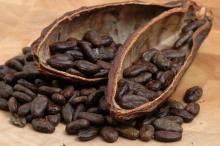NEW ORLEANS – Could chocolate exacerbate acne after all?
Dermatologists have long dismissed the idea that diet is related to acne, despite some patients’ insistence that eating chocolate, for example, seems to worsen their skin disease. But a new study has demonstrated that the consumption of pure chocolate does, in fact, exacerbate acne in a dose-dependent fashion.
Previous studies have failed to show a link between acne and the ingestion of chocolate. But these negative studies were conducted with chocolate candy, which contains sugar, milk, and other adulterants, according to Samantha Block. What’s different about the new study is that it was performed with unadulterated chocolate made of 100% cacao, Ms. Block explained at the annual meeting of the American Academy of Dermatology.
She reported on 10 male subjects (aged 18-35 years) with one to four acne comedones and/or papules on the face, but no nodules, pustules, or cysts. The investigators sought subjects with this minimal degree of facial acne so that any changes during the study period would be easily detected. The participants were invited to eat up to 12 oz. of Ghirardelli unsweetened, 100%-cacao chocolate at a single sitting, or as close to it as they could come. They were instructed to consume their customary diet for the next week. They returned for facial acne lesion counts and photographs on days 4 and 7. None of the participants was on any prescription or OTC medication.
The mean total acneiform lesion count climbed from 2.7 at baseline to 13.4 on day 4 and to 18.2 on day 7.
"We saw a dose-dependent relationship. If you ate more chocolate, you developed more lesions, supporting the idea of a causal relationship," said Ms. Block, a medical student at the University of Miami.
The lack of a control group was a study limitation, she said. However, she and her coinvestigators are now conducting a confirmatory placebo-controlled study.
One audience member, noting that the acne literature states that microcomedone formation takes 6-8 weeks, asked how this time frame jibes with the observed sharp increase in lesion counts just 4-7 days after ingestion of a big bolus of chocolate.
Dr. Brian Berman, senior investigator in the chocolate study and professor of dermatology and internal medicine at the university, replied that the working hypothesis is that the acne-prone study participants may have already had microscopic microcomedones at baseline, and eating the chocolate sped up their expression as clinical lesions.
Audience member Dr. F. William Danby of Dartmouth Medical School in Hanover, N.H., suggested that the investigators take a close look at theobromine as a potential source of the chocolate-associated acne exacerbation they documented. Chocolate contains theobromine, a bitter-tasting isomer of theophylline with a variety of physiologic effects, and 100% cacao presumably carries an exceptional theobromine load.
Ms. Block declared that the chocolate study was conducted independent of commercial sponsorship, and that she has no relevant financial interests.


